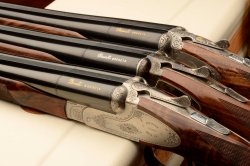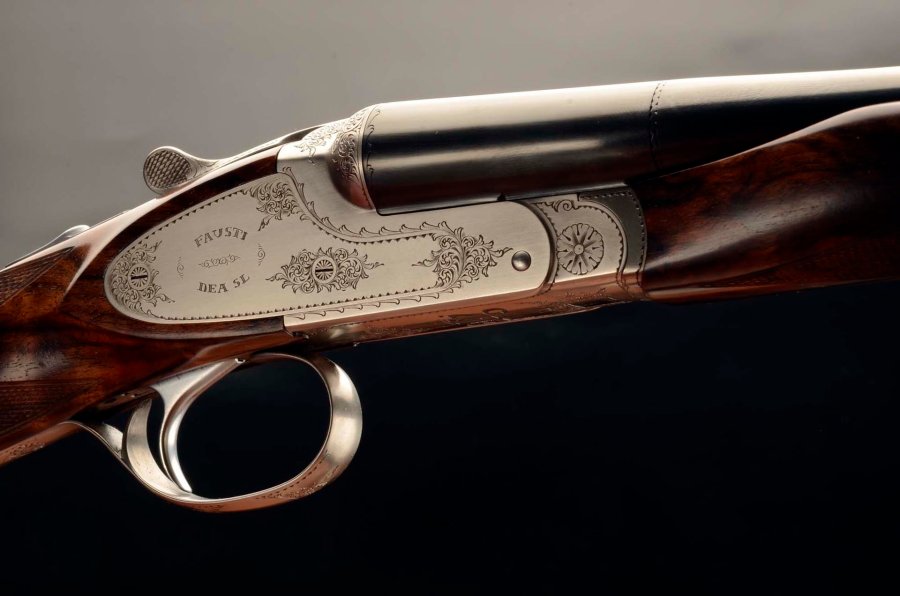

Some even say that with the .410 you can strike down pheasant at more than 50 meters. This is a benevolent exaggeration even if it may be true. The smaller sizes are made for short distances and a .410 cannot certainly be compared with a 12 gauge, even if the improvements made in the boring of the barrels have led to a different behavior in the ammunition. Currently, on a shot pattern of one meter in diameter, we no longer look for the unlikely homogeneous distribution of the pellets, which, with traditional 13 g lead cartridges, would give rise to depleted shot patterns. On the other hand, if with a 12/76 gauge and a 42-gram load we have triple the amount of pellets to be distributed in the same shot pattern of one meter, it is evident that the two situations, 12 and .410, are too different to be comparable. This is where the new boring of current barrels and with consequent improvement of performance comes in. Basically, the difference is in the fact of having a non-homogeneous distribution of pellets, but that are concentrated in the central 40-50 cm radius of the shot pattern. Without proper proportions of the areas concerned and the weight of the shot charge, with the same number of pellets, the central 40-50 cm of the shot pattern of a .410 is guaranteed just like the shot pattern of one meter with a 12 gauge and 32 grams of lead.
Naturally, accuracy comes into play here. With the small gauges, the hunter must shoot straight and calculate hold off with extreme accuracy. At that point, we will see the pheasant close its wings and go down; proportionally, we will have a greater number of shots and a smaller number of injuries compared to game shot with a swarm of pellets from the customary 12 caliber. Naturally, for the same ability of the hunter and shooting accuracy, the number of shots to be fired to obtain the same number of pheasants is greater with the .410 compared to 12 gauge, because the .410 does not forgive those small errors that would be inconsequential with 32 -34 grams. But the greater yield is paid off with a greater number of wounded animals, at the expense of hunting ethics.

What is certain is that with a traditional charge of 13 g of lead and with the barrel boring techniques used up to a few years ago, the shot at 50 m was not even to be attempted. Unless, of course, the distances were roughly estimated with a lot more optimism, similar to how fishermen, boasting, estimate the size of their last catch, fished from the water the size of anchovies and immediately turned into tuna, if not marlins, in fishing stories.
Without exaggeration and with much attention to the hunting results, the Fausti sisters have a long tradition with small gauges, which are to be praised, because, they manufacture double-barreled guns in Marcheno. The double-barreled gun is a difficult gun, which does not allow for shortcuts, because a length wise stress tendency is added to the rotary torque typical of break action guns.

The first barrel pulls the gun to the right and the other to the left. The design of the double-barreled guns has been encoded for more than a century and does not allow for formal uncertainties, especially in small and very small gauges, because there is the need to create an elegant and small receiver, appropriate to the gauge, to avoid creating an ugly gun that would be too unpleasant to bear. This is not only about reducing the proportion and percentage of the size of a larger gauge, you need to know exactly what you are doing.
The difficulties increase if the double-barreled gun we’re talking about has a “real” Anson boxlock mechanism and not the traditional Garda box lock with coil springs.
Fabio Rizzini introduces us to the features and manufacturing philosophy on which the Dea British Club .410 line, built by Fausti Stefano Arms, is based upon

Only the gauge is reduced on these guns, but the space in which to obtain the four longitudinal pylons of the employed system are also reduced.
And, with the 19 gram lead loads, all the mechanical stresses are proportionally reduced to less than dimensioning, which transfers from a 18.3 mm diameter on the 12 gauge to 10.4 mm, but with much higher pressures, on the gauge in question.


We can be aware immediately of the pressures when examining the breech of barrels: if we did not know what weapons we were talking about, and if we were to rely solely on still images, you would think that we would be talking about an express and not to a lean and nimble smoothbore double-barreled gun. There are three versions of this gun with identical mechanics but different finishes and performance.
Since they are mechanically identical and the woods used are always of high quality, well mineralized, solid and with properly arranged fibers, it is almost difficult to talk about “different” versions. They are simply three different productions that can be chosen according to an individual preference without ever having to consider the choice made to be inferior to the other two versions.
The writerʼs preference goes to the colour case hardened version, with less engraving and a thin clear rim surrounding the false lock plate. The latter is a choice that I do not share, because a traditional Anson solution does not have any need to be disguised and it is not inferior to a side plate lock solution, especially if we consider that the first manufacturer to adopt it was Westley Richards, not an unknown blacksmith who clumsily threw together shooting irons in a basement. If we also consider that the small receiver of a .410 naturally enhance the breast size, then this in itself provides a strong individuality.



The receiver especially designed for the small gauge Magnum has no need for intervention from the aesthetic point of view. The trigger is a single trigger, which allows for an oval trigger guard proportioned to the receiver, and is of the sequential type. On the .410, it would certainly be possible to have a single selective inertial type trigger, which would work very well despite the low recoil, but in guns of this type, dedicated to specialized hunts, it is an unnecessary complication that should be avoided.



The interior of the beaver tail rods, a compulsory choice together with the English stocks, because of the small size of the barrels, has decorated screws and is very clean in appearance; the barrel hook shows correct signs of contact and dragging, which are also a good choice and are found in the cross head and hinge circle. The generously sized and extremely robust extractors use the quadrilateral section stem studied by Fausti. This stem does not require a secondary reference stem to prove that there is room for technology upgrades even on a classic rifle such as the double-barreled gun. The three different versions of the gun give a wide possibility of choice and thus everyone can find the solution that they consider most convincing.
Technical Specs
| Manufacturer | Fausti Stefano S.r.l., via Martiri dellʼIndipendenza 70, 25060 Marcheno (BS) |
| Model | Gea Club 410, in three versions |
| Type | Side by side double barrel smoothbore |
| Gauge | .410 |
| Chamber | 76 mm |
| Barrels | Monobloc assembled |
| Barrel length | 71 cm |
| Chokes | Fixed (3/1) |
| Sight | Bead |
| Extractor | Automatic |
| Receiver | High strength steel alloy |
| Action | DoublePurdey |
| Battery | Anson-Deeley type box lock |
| Trigger | Sequential single trigger |
| Handguard | Beaver tail |
| Stock | Selected walnut |
| Weigth | 2,300 kg circa |
| Included | ABS case, barrel and stock cover |











